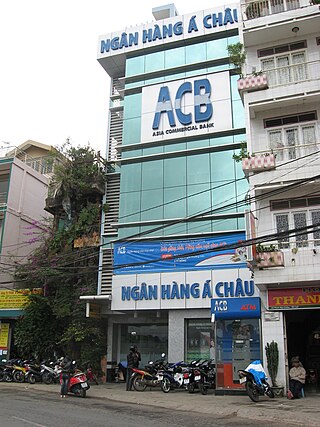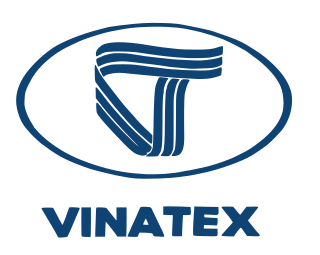Related Research Articles

Shinhan Bank Co., Ltd. is a bank headquartered in Seoul, South Korea. It was the first bank to be established in Korea, having been founded in 1897 under the name Hanseong Bank. The bank was reestablished in 1982. It is part of the Shinhan Financial Group, along with Jeju Bank. Chohung Bank merged with Shinhan Bank on April 1, 2006.
The Vietnam Bank for Agriculture and Rural Development or Agribank is the largest commercial bank in Vietnam by total assets. It is a state-owned corporation under a special status. According to a report by the United Nations Development Programme, Agribank is also the largest corporation in Vietnam.

Asia Commercial Bank, often abbreviated to ACB, is the largest private bank in Vietnam by assets, headquartered at 442 Nguyễn Thị Minh Khai, Ward 5, District 3, Ho Chi Minh City. It was registered on 19 May 1993 and began operations in June 1993. The bank trades at the Ho Chi Minh Stock Exchange under the symbol ACB, where it listed on December 9, 2020 after previously trading at the Hanoi Stock Exchange.

The Joint Stock Commercial Bank for Investment and Development of Vietnam, commonly known as BIDV, is a Vietnamese state-owned bank in Vietnam. It is the country's biggest bank by assets as of June 2021. According to the United Nations Development Programme report on the 100 largest enterprises in Vietnam, BIDV came in at the 4th position after Agribank, VNPT, and EVN.

The Vietnam National Textile and Garment Group (Vinatex) (Tập đoàn dệt may Việt Nam) is a large Vietnamese textile company, and one of Vietnam's largest companies overall. The company's 'productive sector' consists of over 50 joint stock companies, and 40 joint venture companies, principally involved in manufacture; other listed company sectors include fashion magazines, fashion design institutes and textile-industry vocational schools, universities, real estate, supper market. Vinatex operates several import-export companies. Company central offices are located in Hanoi.
TPBank is a bank of Vietnam. It was founded on 5 May 2008, TPBank inherits technological expertise and financial strength from its strategic shareholders, including DOJI Gold and Gems Group, FPT Corporation, MobiFone Corporation, Vietnam National Reinsurance and SBI Ven Holding Pte. Ltd, Singapore.

The Orient Commercial Joint Stock Bank is a joint-stock commercial bank in Vietnam. Its Swift code is ORCOVNVX.
The Vietnam Joint Stock Commercial Bank for Industry and Trade, trading as Vietinbank, is a state-owned Vietnamese bank. As of 2023, it is Vietnam's second-largest bank, with VND 1,800 trillion of assets under management.
LPBank is a Vietnamese retail bank based in Hanoi. As of December 31, 2023, LPBank's total assets reached over VND382,953 billion, up 17% from the beginning of the year. Market segment 1 mobilization activities reached VND285,342 billion; credit growth reached VND39,686 billion with a rate of 16.83%, in line with the ceiling allowed by the State Bank of Vietnam. As of the end of 2023, LPBank's NPL ratio was 1.26%, lower than the same period (1.45%) and much lower than the third quarter of 2023.

Joint Stock Commercial Bank for Foreign Trade of Vietnam, commonly referred to as Vietcombank, is a commercial bank in Vietnam.

Vietnam Technological and Commercial Joint Stock Bank, commonly referred to as Techcombank, is a publicly listed Vietnamese bank. Its shares are traded on the Ho Chi Minh City Stock Exchange under ticker TCB.

Vietnam Post is the Vietnamese government-owned postal service.

The Vietnam International Commercial Joint Stock Bank(Vietnamese: Ngân hàng TMCP Quốc tế Việt Nam), abbreviated as "VIB", is a commercial bank in Vietnam. It was established in 1996 and is headquartered in Ho Chi Minh City. VIB is one of the largest banks in Vietnam, with a total asset of over VND 383,000 billion as of December 30, 2023.

Eximbank(Vietnamese: Ngân hàng thương mại cổ phần Xuất Nhập khẩu Việt Nam) was established on May 24, 1989, and is one of the first joint-stock commercial banks in Vietnam. Eximbank officially started operating on January 17, 1990.
Vietnam Maritime Commercial Joint Stock Bank (MSB), formerly known as Maritime Bank is the first commercial joint stock bank to be granted a license in Vietnam.

Sai Gon Joint Stock Commercial Bank or Saigon Commercial Bank, abbreviated as SCB, is the largest commercial bank in Vietnam by assets, founded in 2012 and headquartered in Ho Chi Minh City. It was founded by the fusion of 3 small banks and was controlled by businesswoman and real estate developer Trương Mỹ Lan. From 2012 until 2022 SCB issued Lan 93% of its loan portfolio, more than 2,500 loans worth over US$44 billion.

Military Commercial Joint Stock Bank, commonly referred to as MB Bank, is a Vietnamese commercial joint stock bank, a subsidiary of the Ministry of Defense of Vietnam.
Saigon Thuong Tin Commercial Joint Stock Bank, commonly referred to as Sacombank, is a Vietnamese commercial joint stock bank established in 1991.

Xanh SM, also known as Taxi Xanh SM or GSM is a taxi company in Vietnam. This company operates in two main fields: electric taxis and rental of electric cars and motorcycles from VinFast, with an investment scale of 10,000 cars and 100,000 motorcycles. It is the first all-electric taxi company in Vietnam.
References
- 1 2 3 Vietnam country study. Library of Congress Federal Research Division (December 1987). This article incorporates text from this source, which is in the public domain.
- ↑ Archived 2013-11-25 at the Wayback Machine . Saigon Times ATMs overwhelmed by huge crowds (January 2011).
- ↑ "Vietnam to allow higher bank investments". Investvine.com. 2013-03-01. Retrieved 2013-03-05.
- ↑ Cổng Thông tin điện tử Chính phủ. "Thông tư số 40/2011/TT-NHNN của Ngân hàng Nhà nước Việt Nam". vanban.chinhphu.vn (in Vietnamese). Retrieved 2024-02-07.
- ↑ "Điều lệ ngân hàng sau cổ phần hoá xây dựng sao cho phù hợp?" (in Vietnamese). Retrieved 2024-02-07.
- ↑ "Pháp luật về quản trị ngân hàng thương mại cổ phần ở Việt Nam | Tạp chí Điện tử Luật sư Việt Nam". lsvn.vn (in Vietnamese). Retrieved 2024-02-07.
- ↑ "Trình tự cấp Giấy phép thành lập và hoạt động của Ngân hàng thương mại cổ phần". xaydungchinhsach.chinhphu.vn (in Vietnamese). 2023-12-14. Retrieved 2024-02-07.
- ↑ "Ngân hàng Nhà nước Việt Nam". vbpl.vn. Retrieved 2024-02-07.
- ↑ "Nghị định số 59/2009/NĐ-CP của Chính phủ: Về tổ chức và hoạt động của ngân hàng thương mại". chinhphu.vn (in Vietnamese). Retrieved 2024-02-07.
- ↑ VCCorp.vn (2022-03-18). "[Có thể bạn chưa biết] Năm nay và năm sau có rất nhiều ngân hàng đón sinh nhật tuổi 30". cafef (in Vietnamese). Retrieved 2024-02-07.
- ↑ "Nhân sự ngân hàng biến động ra sao trong năm qua?". VietNamNet News (in Vietnamese). Retrieved 2024-02-07.
- ↑ "Ngân hàng Nhà nước mạnh tay nới lỏng chính sách tiền". mof.gov.vn. Retrieved 2024-02-07.
- ↑ "Toàn cảnh 5 cuộc đại phẫu ngân hàng hơn 2 thập kỷ qua". baodautu (in Vietnamese). Retrieved 2024-02-07.
- ↑ "Ngân hàng nông thôn đầu tiên lên ngân hàng đô thị" (in Vietnamese). Retrieved 2024-02-07.
- ↑ "Ngân hàng TMCP nông thôn Hải Hưng được chuyển đổi mô hình hoạt động" (in Vietnamese). Retrieved 2024-02-07.
- ↑ thuvienphapluat.vn. "Công văn 7171/NHNN-CNH thông báo ý kiến chỉ đạo của Thủ tướng Chính phủ CV 4944/VPCP-KTTH". THƯ VIỆN PHÁP LUẬT. Retrieved 2024-02-07.
- ↑ Tran, Quoc Bao (2008-08-08). "E visa gift card". hanoimoi.vn (in Vietnamese). Retrieved 2024-02-07.
- ↑ "Tăng vốn để tăng quy mô hoạt động ngân hàng". mof.gov.vn. Retrieved 2024-02-07.
- ↑ baochinhphu.vn (2007-06-13). "Thành lập Ngân hàng thương mại cổ phần phải có số vốn pháp định tối thiểu 1000 tỷ đồng". baochinhphu.vn (in Vietnamese). Retrieved 2024-02-07.
- ↑ Trí, Dân (2008-08-09). "Tạm dừng cấp phép thành lập ngân hàng". Báo điện tử Dân Trí (in Vietnamese). Retrieved 2024-02-07.
- ↑ "Tạm dừng lập ngân hàng thương mại cổ phần". tuyengiao.vn (in Vietnamese). Retrieved 2024-02-07.